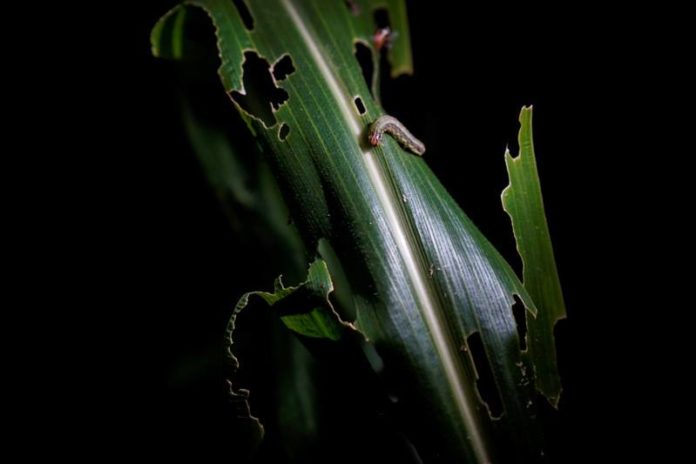
Yan Wenliu leans on the side of his cart as he prepares to leave his sugarcane field in Southwest China, bewildered by the formidable new pest that has ambushed his crops this year.
“I don’t know what it is,” says Yan, a 36-year-old farmer from Menghai county in Yunnan province. “But it is bigger than other ones. I have never seen this worm before.”
The creature Yan is unable to name is fall armyworm. Known locally as the “heart-devouring worm,” the destructive pest has spread more than 3,000 km (1,865 miles) north since migrating from neighbouring Myanmar seven months ago, reaching 21 provinces and regions in China and posing a grave threat to grain output.
In Yunnan alone, where the pest struck first in China, some 1.29 million mu (86,000 hectares) had been affected by mid-June, including corn, sugarcane, sorghum and ginger crops.
This poses a formidable challenge in China where about 90% of crop production comes from small farms of less than a hectare (2.5 acres) and owners lack basic knowledge and resources to tackle the pest.
Beijing warned earlier this year that armyworm was a severe threat to the country’s food security and in May launched a campaign to “snatch grain from the insect’s mouth.”
Millions of yuan have been allocated to affected regions and experts sent to educate farmers.
PESTICIDE OR PENNILESSTo those in Yunnan, the solution to the worm problem seemed obvious – pesticide. “You have to keep spraying chemicals. If you don’t kill the worm, you will end up penniless,” says sugarcane farmer Yan in Mengkang village.
But paying for the pesticide in the quantities required has left many farmers out of pocket, while a failure to follow the complex regime needed – using different pesticides at different crop growth stages and rotating them to prevent resistance – means the money is often wasted.
“You just can’t kill them,” says Yan Hannen, a 44-year-old farmer, from nearby Nuodong. “I have been farming for 20 years but have never seen this many worms.”
A frustrated Yan applied pesticides fives times to his last crop of sweet corn, but output nearly halved. He has already sprayed his new crop twice, to little effect.
“They told me to use one bucket but I used three. It still did not work. What can you do?” he asked.
Local government has held many meetings to brief farmers on the pest and villagers have improved their approach to using pesticides, said Yan Xiangwa, a village official in Nuodong.
But for farmers who have already battled severe drought this year, the latest threat has put their entire livelihoods at risk.
Villagers tend to give up treatment due to the high cost, the Yunnan provincial government said in a report last month, adding that sufficient human resources for plant protection were also lacking at the local level.
Yu Xianger, another Nuodong farmer, sprayed pesticide on her 2 mu (0.13 hectare) of corn field without results and is thinking about finding work in the city.
“The worms have devastated my corn crops this year. And there’s nothing much else I can do,” she said.
COMPLEX FIGHT
Experts say the fight against armyworms is difficult and the enemy is a tough one. Adept at hiding, the pest is hard to detect and prefers to venture out at night, to feast on plants and fly to new pastures.
“Local farmers here didn’t use much pesticide before and wouldn’t buy chemicals until they saw the worms, meaning they might have missed the best time to kill them,” said Yao, a sales manager for pesticide supplier Jingbo Agrochemicals Technology Co. Ltd. In Xishuangbanna, Yunnan province.
The villagers’ slow response to the arrival of armyworm was not helped by the absence of a trapping system involving lights and pheromones that Beijing says is currently being deployed nationwide.
Despite the problems in the country’s south, the outlook for China’s main corn production area in the north is “much better,” says Hu Gao, professor of insect ecology at Nanjing Agricultural University.
Control and prevention measures have given the region, which accounts for more than 70% of China’s corn production, more time to prepare for an invasion.
The worm has yet to reach the northeastern provinces including Heilongjiang, the top grower of the grain, and some experts believe the lower temperatures in the region will protect it from a full attack.
Back in Yunnan, however, farmer Yan Hannei is thinking about switching to other plants like vegetables.
“I am going to lose so much money this year,” he says. “What can you do? I can only stop growing corn and grow something else.”
(Reporting by Hallie Gu and Ryan Woo; additional reporting by Beijing Newsroom; Editing by Tom Daly, Christian Schmollinger and Richard Pullin)







